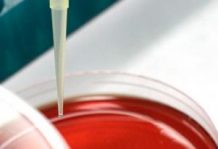In oligotrophic environments (lack of nutrients), most bacteria (and some fungi) leave their state of individual planktonic cells to grow as biofilms, forming colonies embedded in a matrix bonded to the surfaces provided by needed nutrients. Biofilm formation is a survival strategy for bacteria, giving them a number of advantages: sheltered environment, better uptake of nutrients, etc.
Physiological heterogeneity
A wide variety of markedly heterogeneous microniches or microenvironments that are close together can exist within a biofilm where microorganisms compete for space under varying conditions. Environmental conditions, such as pH, temperature, nutrient concentration, etc. can be highly variable, which causes bacteria of the same species to have very different physiological states or bacterial species with different physiological requirements (anaerobic, aerobic, microaerobic) to coexist while separated by just 10 µm.1,2
In this complex heterogeneous community structure, microorganisms live together, cooperate, interact and communicate through a system of signals that direct the phenotype and regulate gene expression. The clinical importance of this intricate biofilm ecosystem lies in the ability of these microbial communities to change in response to treatment intervention.
Greater phenotypic resistance
Bacteria growing sessily in biofilms exhibit a phenotype that differs from that shown by bacteria that grow in suspension, or planktonically, expressing genes that are never expressed in placktonic form and that give them resistance to antibiotics, to environmental stress and to host defense (antibodies and phagocytic cells). This resistance is maintained even when they are released from the biofilm2.
Interbacterial communication
Bacteria that live together in a biofilm are able to communicate with each other either by using chemical signals or by transferring genetic material through conjugation mechanisms (plasmid and transposon transfer) and transformation2.
Quorum sensing is an important phenomenon that occurs via chemical signals3. This is a phenomenon by which bacteria perceive bacterial population density existing in their close surroundings through specific biosensoring mechanisms (accumulation of molecules with signalling function). When this density reaches a critical level, a specific, genetically set bacterial response is triggered.
Quorum sensing can provide biofilms with some of their characteristic properties, both in terms of their development, and of their greater resistance to antimicrobials. For example, it can promote the expression of genes that encode for resistance to a certain antibiotic from a certain cell density; it can also have the ability to affect biofilm structure, stimulating the growth of beneficial species and inhibiting the growth of competitor species2.
In short, their capacity to communicate with each other affects their resistance to antimicrobials, production of virulence factors and the biofilm structure itself.
Adaptive capacity
Under favourable environmental and nutritional conditions, biofilms must maintain a balance between the growth and maintenance of its structure. When faced with unfavourable conditions, biofilms are able to regress to earlier stages, while maintaining their structure and their surface adhesion, and are able to develop again when conditions improve4.
Resistance to antimicrobial agents
As mentioned above, one of the characteristics of biofilms is their great antimicrobial resistance. This quality may be due to several circumstances: the protection that the exopolysaccharide matrix provides to bacteria; lower -non-effective- concentration at which antimicrobials reach the deepest areas of the biofilm; the ability of bacteria attacked with sublethal doses to develop antimicrobial resistance; the activation of genes that provide greater antimicrobial resistance by sessile bacteria compared to planktonic bacteria; the quiescent state of bacteria in the deep regions of the biofilm, due to the lower supply of nutrients, which makes them less susceptible to antimicrobial action.
- Costerton JW. Biofilms, the customized microniche. J Bacteriology 1994;176:2137-42.
- Socransky SS, Haffajee AD. Biofilms dentales: objetivos terapéuticos difíciles. Periodontol 2000 2003;3:12-55.
- Piqueras M. Fichas de Medtrad. Ficha n.º 5: Quorum sensing. Panace@ Vol. 2, n.º 6. Diciembre, 2001.
- Serrano-Granger, J. Efectos de un colutorio con Clorhexidina al 0,05% y Cloruro de Cetilpiridinio al 0,05% en pacientes en mantenimiento periodontal. Tesis Doctoral. 2007. URL Oficial: http://eprints.ucm.es/tesis/odo/ucm-t29610.pdf
 initiative
initiative 
